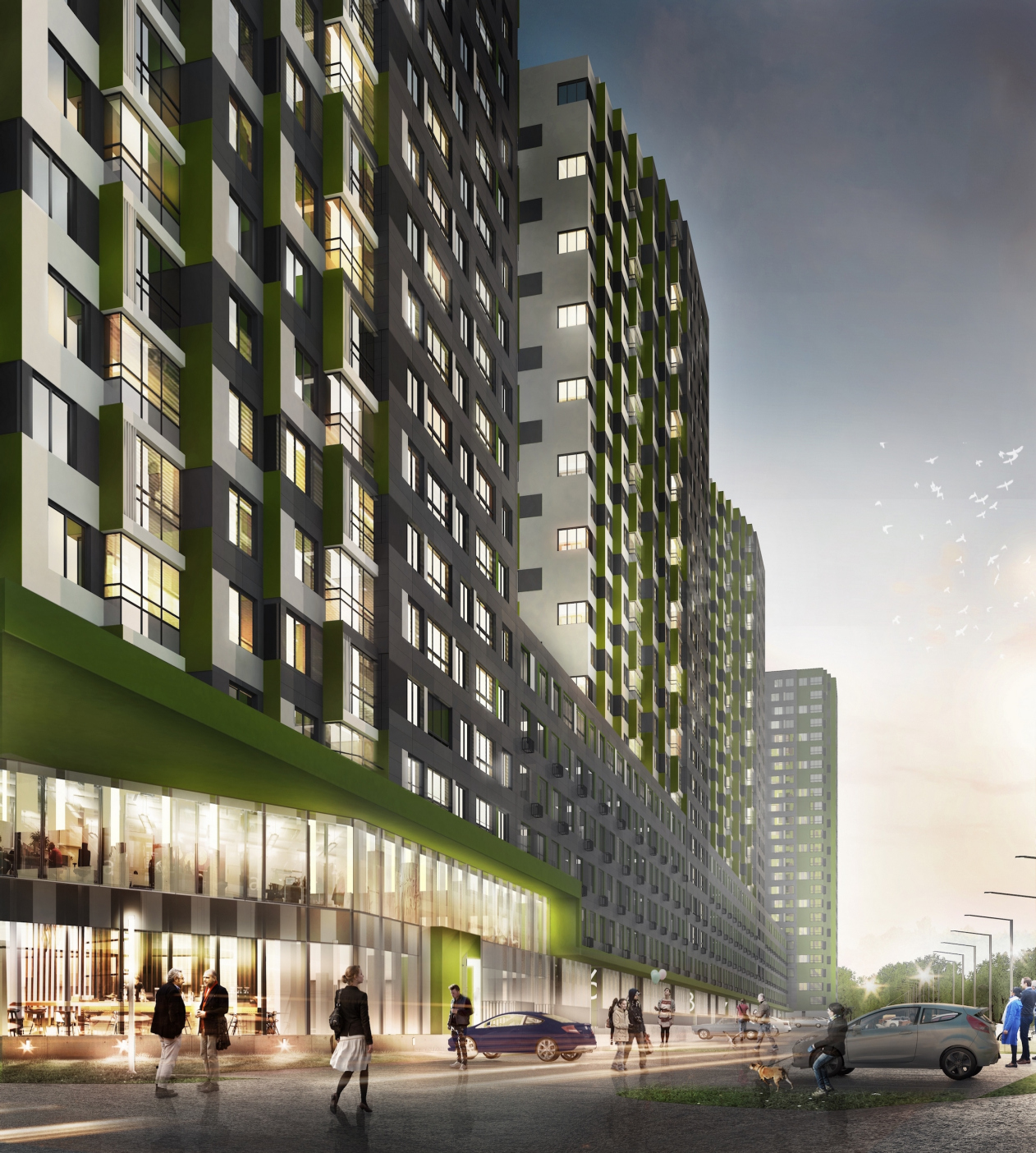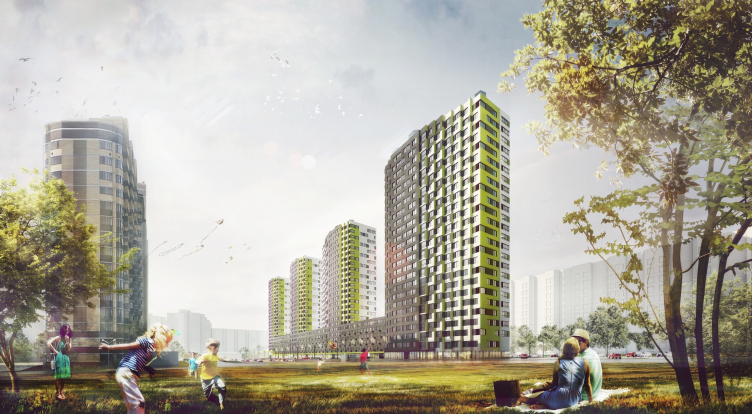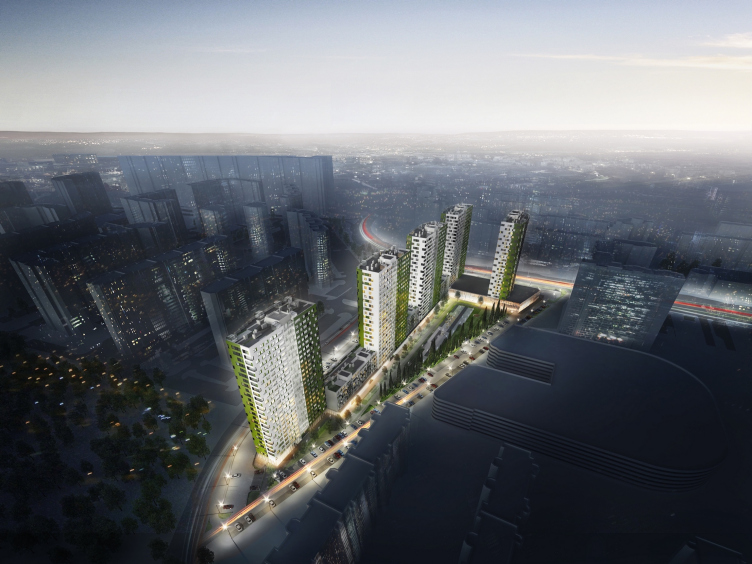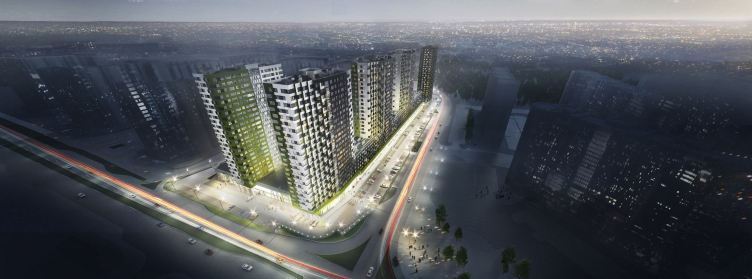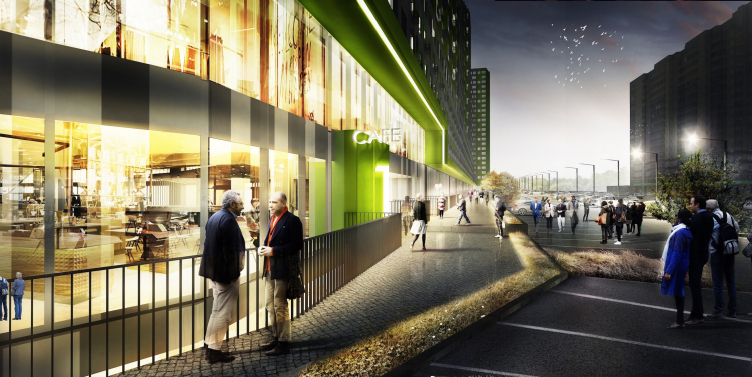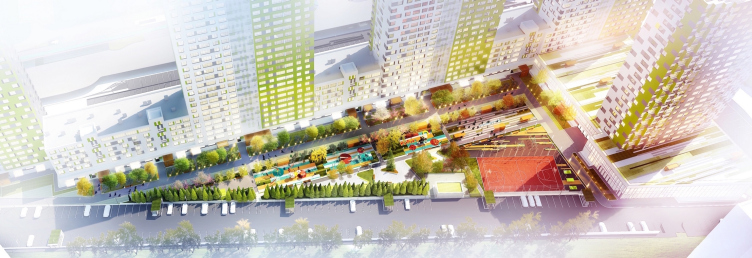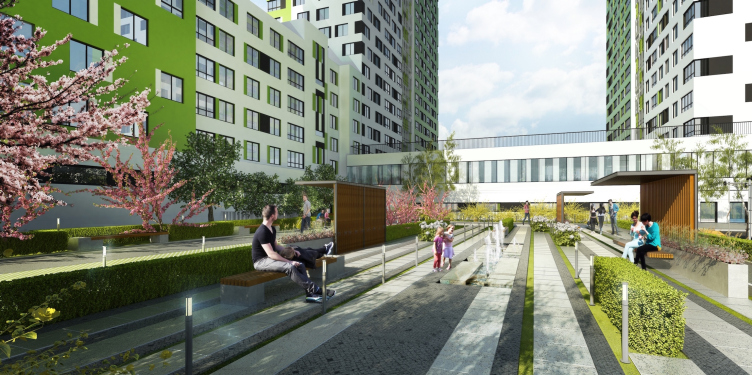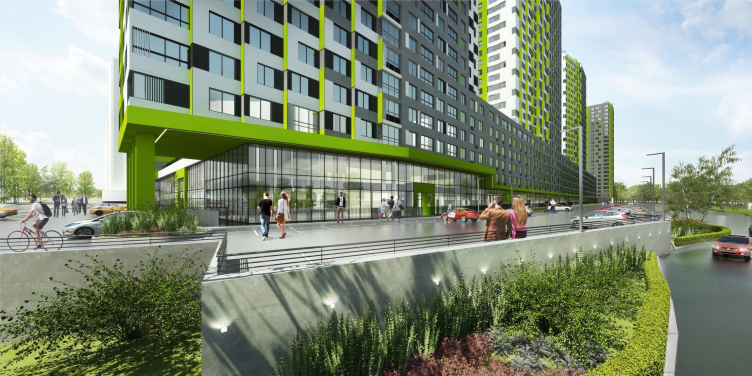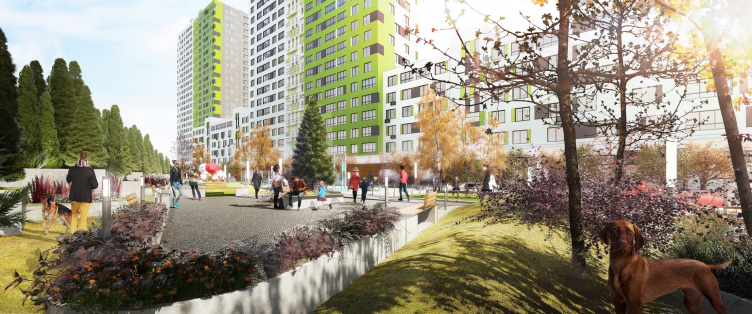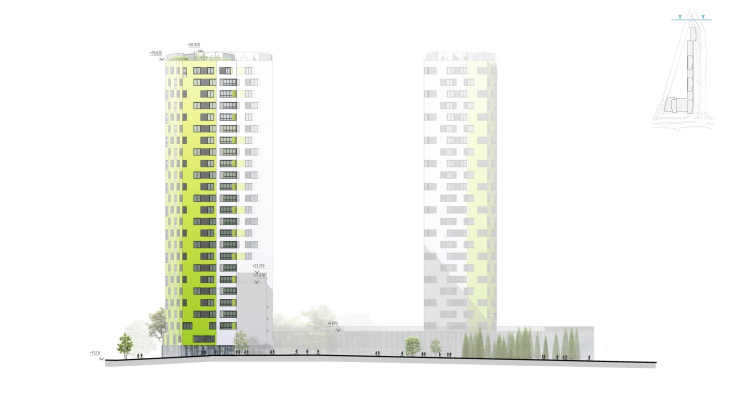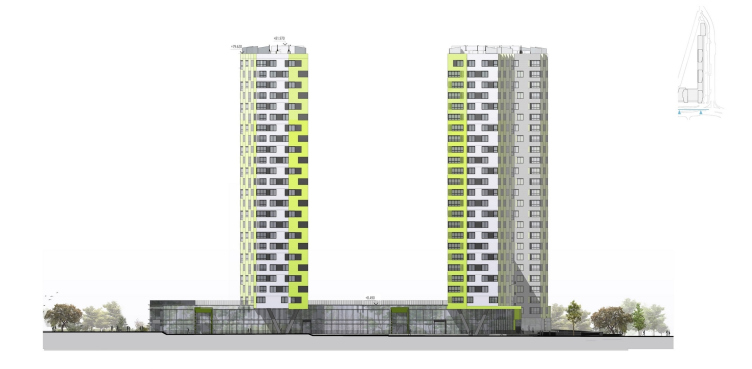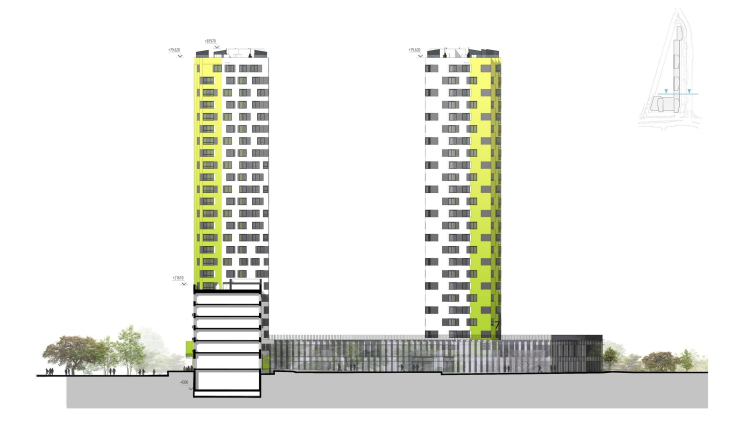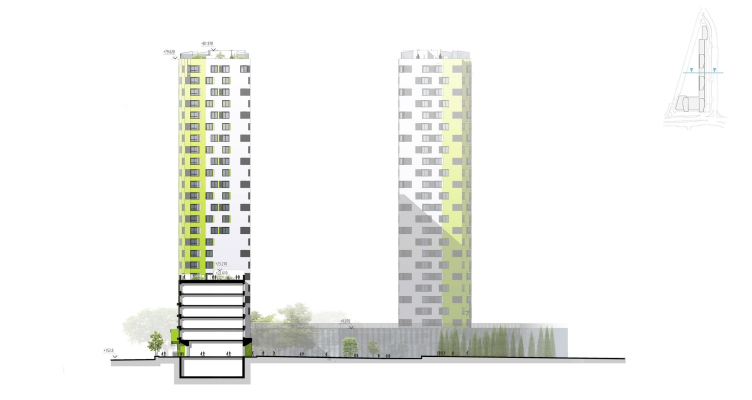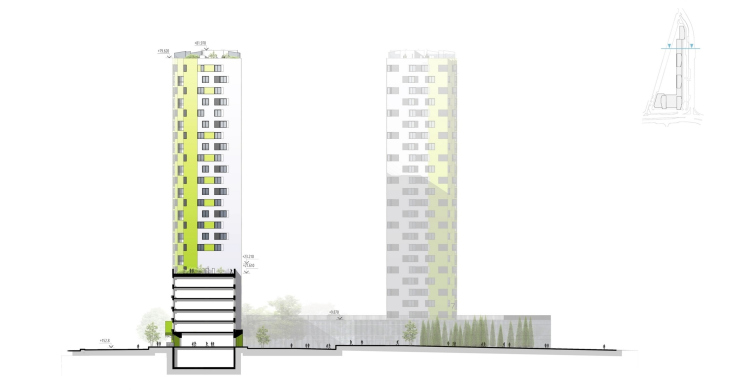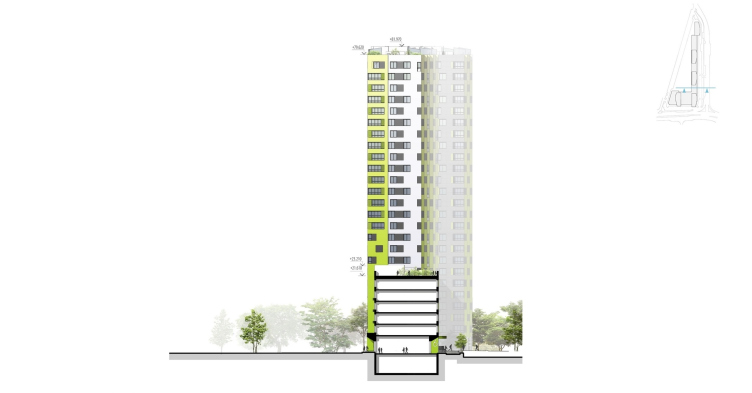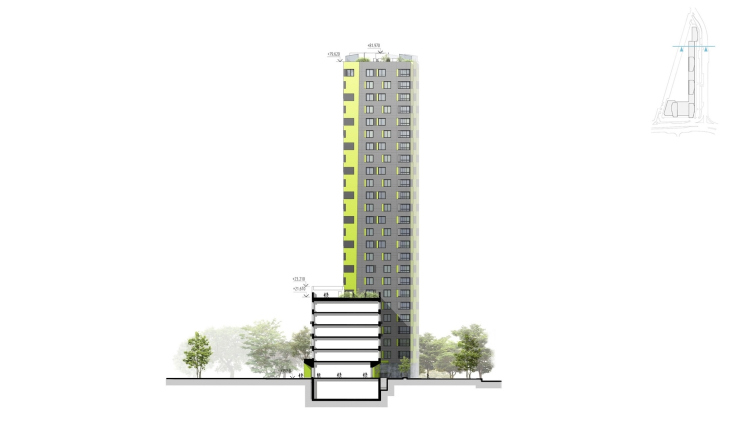The residential complex “Russia. Five Capitals” was designed by Sergey Oreshkin for Voronezh. It occupies the western part of the new residential neighborhood “Troitsky” named after the architect Nikolai Troitsky who headed the restoration of Voronezh after the Second World War. The location of the new area with a binding “architectural” name proved to be a lucky one – practically between the park of Biotechnology Institute and the Botanical Garden of the Voronezh University, amidst the greenery but at the same time but a ten minutes drive away from the city center. The total area of Troitsky is 29 hectares; its middle part is occupied by the large “Olimpiysky” residential complex that consists of almost-complete 18-story buildings of architecture that is calm and reserved but rather on a simple side and stereotypical. The west and east parts of the complex are occupied by two housing projects also designed by the Saint Petersburg architectural company headed by Sergey Oreshkin: the east side is occupied by the housing complex “Avangard”, while on the west side, on a narrow land site in the shape of a rectangular triangle, its major leg adjoining the Zagorovskogo Street – “Russia. Five Capitals” is situated. The acute angle of the triangle is pointed northward into the tree nursery, while the minor leg of the triangle adjoins the broad highway of the Shishkova Street that makes here a smooth 90-degree turn.
The five 25-story towers that gave the complex its name were the client’s idea. Sergey Oreshkin proposed to unite them with an L-shaped podium. On the east side, one that stretches along the relatively quiet Zagorovskogo Street, the slabs of towers, placed in a ship’s wake fashion, alternate with six-story buildings that face the street with a building front of a human-friendly “city” scale (regretfully, not supported by the neighboring buildings but valuable nonetheless). The podium of the minor leg has two stories in it; it carries but two towers that are shifted forward upon slender pillars of galleries set in a futuristic fashion. From this side, the complex is permeable; it looks like it opens up the giant “blinds” letting into the center of Voronezh a stream of fresh air from the park. Or maybe the other way around: it asserts itself as a pair of giant propylaea.
Housing complex "Russia. Five Capitals". Project, 2016 © A.Len
Housing complex "Russia. Five Capitals". Project, 2016 © A.Len
Housing complex "Russia. Five Capitals". Project, 2016 © A.Len
The extreme northern tower – the “nose” of Unit 9 pointed towards the tree nursery – is slightly shifted off the main “ship’s wake” towards the west, thus opening the forest views to the towers of the central part. For the same purpose – catching more panoramic views – the towers took on a somewhat spindle-like quality: their walls are slightly slanted, while the balconies turned on the direction of the best views form a cascade of steps, the further ones standing out more than the closer ones.
The second “panoramic segment” of the complex is the south one. From this side, the complex commands city views, and it is also built in a cascade fashion. “This, of course, is a rather interesting place. Here, the land site comes out to a great wide open in terms of panoramic views. At that point, the Shishkova Street takes a turn and keeps going down all the time. This opens up a rather wide space between the buildings, and this mesmerizing bend of the road is clearly seen, stretched into the distance of the land” – shares Sergey Oreshkin.
Housing complex "Russia. Five Capitals". Project, 2016 © A.Len
The client opted out of insisting on the idea of painting each of the towers its individual color, and the architects were able to come up with an integral color design solution for the façades: in gray and white colors, with bright green inserts – it all looks almost like a metaphor of the famous local “black soil”, through which the young offshoots are showing. The extended outside eastern wall is dominated by black, the yard is half white, half green but the colors blend here: for example, the outside parts of the towers smoothly grow white, thus making their silhouette look more elegant. This smoothness, however, is relative, of a pixel kind – the black and white frames of the stanzas first alternate, overlapping in a staggered order, but white “takes over” with every next step leading outside. The green side walls of the stanzas also come into play, first only “igniting” here and there, and then blending into spots of happy green in the distance.
“The towers grow from a multistory podium like stalagmites: the material used in the bottom part goes over to the top part, and then the upper part begins to “pixelate” – this is how Sergey Oreshkin describes the image of the building.
Housing complex "Russia. Five Capitals". Project, 2016 © A.Len
The long string cornice of the green awning above the entire podium above the Zagorovskogo Street cuts the transparent glass base away from the point where the black-green-white mass of the building starts to grow. This cutaway has a lot of meaning to it: here, in the glass part, in addition to the retail function, there are also offices situated in the basement, the first floor, and, for the two south towers, on the second floor as well. It is planned to use high-quality glass, without rough seams, and the workspaces will get plenty of natural light.
Housing complex "Russia. Five Capitals". Project, 2016 © A.Len
Housing complex "Russia. Five Capitals". Project, 2016 © A.Len
It is planned that the adjacent land will be very well organized. The functional zones are numerous; landscape elements go one after another, and Sergey Oreshkin likens them to train cars. At the same time, the entire yard is not a very large one, particularly considering the size of the housing complex and the expected number of people that will live here. The yard will be of a residents-only type.
Housing complex "Russia. Five Capitals". Master plan. Project, 2016 © A.Len
Housing complex "Russia. Five Capitals". Birds-eye view. Project, 2016 © A.Len
Housing complex "Russia. Five Capitals". Project, 2016 © A.Len
The yard territory will include volleyball and basketball grounds, a piazza with a fountain, flowerbeds and lawns, an event square, three playgrounds of different content, recreation zones, wooden gazebos, a green amphitheater, a fruit alley running along the hallway lobbies, and five-meter high туи at the border of the yard that will visually separate the territory of the new housing complex from the already-existing bleak buildings. At this same “border zone”, they will make the extra parking lot, even though the complex will have an underground parking garage of its own.
Housing complex "Russia. Five Capitals". Project, 2016 © A.Len
Housing complex "Russia. Five Capitals". Project, 2016 © A.Len
Housing complex "Russia. Five Capitals". Project, 2016 © A.Len
Housing complex "Russia. Five Capitals". Project, 2016 © A.Len
Housing complex "Russia. Five Capitals". Project, 2016 © A.Len
The principle of arranging apartments of different size reminds a layered cake: the more spacious housing is concentrated closer to the bottom part of the complex and on the top floors of the towers, while the main middle part is occupied by studios, two and three room apartments. For the people living on the top floors, the architects designed individual exits to the roof upon which terraces will be organized. All the elevator shafts are grouped at the west façade because it is this façade that faces the comparatively dull-looking neighborhood.
Each of the towers symbolizes one of the Russian “capital cities”: in addition to Moscow and Saint Petersburg, these are Sochi as the city of the Olympics, Yalta as the capital of the Crimea, and Voronezh as the capital of the “black soil” region of Russia. The spacious entrance lobbies and elevator halls of each tower will be designed in accordance with the city that this particular tower represents.
Even a fleeting glimpse at the main mass of the Voronezh newly built stock is enough to see that it is a bit on the monotonous side. “Russia. Five capitals” stands out against this background not only thanks to its colorful façades. A.Len has designed a housing complex that, thanks to the architects’ careful approach to organizing the public space takes the city environment to a whole new level.
Housing complex "Russia. Five Capitals". Facade. Yard 2016 © A.Len
Housing complex "Russia. Five Capitals". Facades. Project, 2016 © A.Len
Housing complex "Russia. Five Capitals". Facade. Unit 5 © A.Len
Housing complex "Russia. Five Capitals" © A.Len
Housing complex "Russia. Five Capitals". Facade, Units 1 and 2 © A.Len
Housing complex "Russia. Five Capitals". Facade, Unit 3 © A.Len
Housing complex "Russia. Five Capitals". Facade, Unit 4 © A.Len
Housing complex "Russia. Five Capitals". Facade, Unit 3 © A.Len
Housing complex "Russia. Five Capitals". Facade, Unit 5 © A.Len
